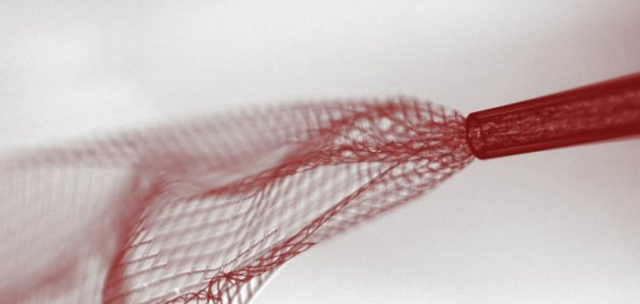Elon Musk, CEO of Space Exploration Technologies (SpaceX) and Tesla Motors, Inc, was at Startmeup Hong Kong and talked about what he thought were areas of technological opportunity.
At 37 minutes into this video Elon Musk talks about high potential technology like Hyperloop which he currently does not have time to address
electric aircraft
genetics is thorny but is our best shot at many tough diseases
brain computer interfaces at the neuron level has potential for intelligence augmentation
Neural Lace was mentioned
Scientists from China and the US have found a pioneering way to inject a tiny electronic mesh sensor into the brain that fully integrates with cerebral matter and enables computers to monitor brain activity.
Researchers from Harvard and the National Center for Nanoscience and Technology in Beijing have succeeded in inventing a flexible electrical circuit that fits inside a 0.1mm-diameter glass syringe in a water-based solution.
This tiny electronic mesh sensor is thin and flexible enough to be injected into the brain and gentle enough to integrate fully with brain cells, making human cyborgs a possibilityLieber Research Group, Harvard University
When injected into the brains of mice, the mesh unfurled to 30 times its size and mouse brain cells grew around the mesh, forming connections with the wires in the flexible mesh circuit. The biochemical mouse brain completely accepted the mechanical component and integrated with it without any damage being caused to the mouse.
The mice who received the implants are thriving and while today they need to be connected by a wire to the computer so their brain activity can be monitored, in the future this could be wireless, and the same technique could be used to integrate an electric mesh with a human brain.
Brain computer interfaces at the neuron level would mean you would never forget anything and have cognitive enhancement.
Seamless and minimally invasive three-dimensional interpenetration of electronics within artificial or natural structures could allow for continuous monitoring and manipulation of their properties. Flexible electronics provide a means for conforming electronics to non-planar surfaces, yet targeted delivery of flexible electronics to internal regions remains difficult. Here, we overcome this challenge by demonstrating the syringe injection (and subsequent unfolding) of sub-micrometre-thick, centimetre-scale macroporous mesh electronics through needles with a diameter as small as 100 μm. Our results show that electronic components can be injected into man-made and biological cavities, as well as dense gels and tissue, with over 90% device yield. We demonstrate several applications of syringe-injectable electronics as a general approach for interpenetrating flexible electronics with three-dimensional structures, including
(1) monitoring internal mechanical strains in polymer cavities,
(2) tight integration and low chronic immunoreactivity with several distinct regions of the brain, and
(3) in vivo multiplexed neural recording.
Moreover, syringe injection enables the delivery of flexible electronics through a rigid shell, the delivery of large-volume flexible electronics that can fill internal cavities, and co-injection of electronics with other materials into host structures, opening up unique applications for flexible electronics.
Neural Dust
Arxiv – Neural Dust: An Ultrasonic, Low Power Solution for Chronic Brain-Machine Interfaces
A major hurdle in brain-machine interfaces (BMI) is the lack of an implantable neural interface system that remains viable for a lifetime. This paper explores the fundamental system design trade-offs and ultimate size, power, and bandwidth scaling limits of neural recording systems built from low-power CMOS circuitry coupled with ultrasonic power delivery and backscatter communication. In particular, we propose an ultra-miniature as well as extremely compliant system that enables massive scaling in the number of neural recordings from the brain while providing a path towards truly chronic BMI. These goals are achieved via two fundamental technology innovations:
1) thousands of 10 – 100 µm scale, free-floating, independent sensor nodes, or neural dust, that detect and report local extracellular electrophysiological data, and
2) a sub-cranial interrogator that establishes power and communication links with the neural dust. For 100 µm scale sensing nodes embedded 2 mm into the brain, ultrasonic power transmission can enable 7 % efficiency power links (-11.6 dB), resulting in
a received power of ∼500 µW with a 1 mm2 interrogator, which is over 10 million more than EM transmission at similar scale (40 pW). Extreme efficiency of ultrasonic transmission and CMOS front-ends can enable the scaling of the sensing nodes down to 10’s of µm.
A major hurdle in brain-machine interfaces (BMI) is the lack of an implantable neural interface system that remains viable for a substantial fraction of the user’s lifetime. Recently, sub-mm implantable, wireless electromagnetic (EM) neural interfaces have been demonstrated in an effort to extend system longevity. However, EM systems do not scale down in size well due to the severe inefficiency of coupling radio-waves at those scales within tissue. This paper explores fundamental system design trade-offs as well as size, power, and bandwidth scaling limits of neural recording systems built from low-power electronics coupled with ultrasonic power delivery and backscatter communication. Such systems will require two fundamental technology innovations: (1) 10-100 μm scale, free-floating, independent sensor nodes, or neural dust, that detect and report local extracellular electrophysiological data via ultrasonic backscattering and (2) a sub-cranial ultrasonic interrogator that establishes power and communication links with the neural dust. We provide experimental verification that the predicted scaling effects follow theory; (127 μm)(3) neural dust motes immersed in water 3 cm from the interrogator couple with 0.002064% power transfer efficiency and 0.04246 ppm backscatter, resulting in a maximum received power of ∼0.5 μW with ∼1 nW of change in backscatter power with neural activity. The high efficiency of ultrasonic transmission can enable the scaling of the sensing nodes down to 10s of micrometer. We conclude with a brief discussion of the application of neural dust for both central and peripheral nervous system recordings, and perspectives on future research directions
